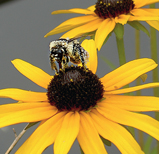
 |
Rebecca Tonietto (G09) has spent the past two summers chasing bees on rooftops and in parks throughout Chicago. Working jointly with the Chicago Botanic Garden and Northwestern, she is conducting the first bee study on green roofs in North America. Her study also examines prairies and parks throughout the Chicago area. So far, her evidence indicates that bees can exist and even thrive in human-dominated landscapes if the habitat is right.

A bumblebee lives the high life on a rooftop garden.
Chicago leads the nation in green roofs, with 4 million square feet as of a year ago. The number keeps going up rapidly, partially thanks to programs introduced by Mayor Richard M. Daley that waive consulting fees and expedite building permits for green buildings.
Tonietto’s urban study sites include the top of Optima Views condo in Evanston, the roof gardens at the Chicago Botanic Garden’s new science center, Peggy Notebaert Nature Museum in Lincoln Park, the CTA headquarters and the green roof at the Joffrey Tower in Chicago. Green roofs, prairie restoration areas and landscaped native prairie plantings within traditional parks, all features of Chicagoland’s urban green spaces, have proven to make successful habitats, unlike the standard lawn that covers many parks.
“One in three bites of food you eat is thanks to bee pollination,” says Tonietto. “Virtually any grown food that is not a grain relies on bees.” According to the USDA, bee pollination is currently a $15 billion industry. Both rural and urban areas have seen a steep decline in bee populations. “Previously ubiquitous species, you just can’t find them now,” says Tonietto. “Native prairie and native plants are needed, otherwise pollinators simply don’t exist.”
Contrary to the hives one might expect, most bee species live solitarily, in holes in the ground — and will continue to do so even if that “ground” is 15 stories in the air.
Despite the decline of the overall population, Tonietto collected a native Midwestern bee never seen in Illinois before, as well as the first find in the Midwest of a European bee that recently spread across New York City’s community gardens. She also logged three other first records for Illinois.
Tonietto, a doctoral student in the Northwestern–Chicago Botanic Garden plant biology and conservation program, came to her current project in a roundabout way. After graduating with a degree in biology from Kalamazoo College, where she did a thesis investigation of aquatic insect responses to large predators in ponds, she switched to dryland insects “to avoid the mosquitoes” and got “hooked on bees” as a research assistant at Princeton. The same pursuit brought Tonietto to the Chicago Botanic Garden. When Northwestern started a partnership degree program with the Garden in 2005, Tonietto applied. Having finished her master’s, she was one of the first two doctoral students to enter the program in 2009.
“The study is a way to show green space utilized by native species of bees. The city’s not uninhabitable, and it gives them options for places to be. Urban green space that’s not turf grass is exciting.” As for the apparent downsides of her job, she’s been “stung in the past, but never on this project.”— Kent Cubbage
Plant biology and conservation graduate student Rebecca Tonietto in this video from the Chicago Botanic Garden.